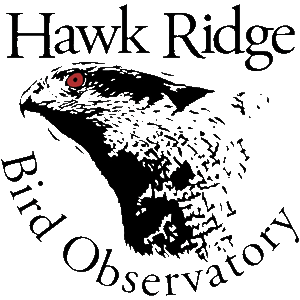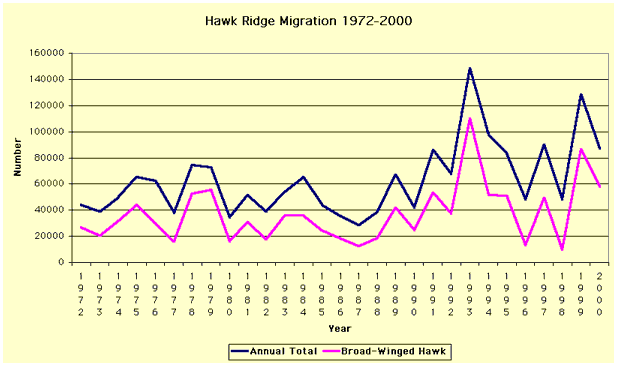 Hawk Ridge
Nature Reserve
Hawk Ridge
Nature Reserve
 Hawk Ridge
Nature Reserve
Hawk Ridge
Nature Reserve
![]()
These pages are intended to be a brief overview of Hawk Ridge. Hawk Ridge Bird Observatory itself has its own more complete and up to date website as well.
The mission of the Hawk Ridge Bird Observatory is to protect birds of prey and other migratory birds in the Western Lake Superior Region through research, education, and stewardship.
Based at a uniquely advantageous location overlooking the western tip of Lake Superior, the primary goals of the Hawk Ridge Bird Observatory are to study one of the greatest migrations of birds of prey in North America; to research the distribution, abundance and migratory pathways of birds in the Western Great Lakes; to educate people about bird conservation; and to serve as stewards of the Hawk Ridge Nature Reserve, the first designated Important Bird Area within Minnesota.
Most raptors are reluctant to cross large bodies of water. When they migrate south and encounter Lake Superior, the birds naturally veer southwest along the lakeshore. They concentrate in impressive numbers on the bluffs overlooking East Duluth and can be easily seen from the overlook at Hawk Ridge. Of the 20 species of raptors and vultures that have been seen at Hawk Ridge Nature Reserve, the Mississippi Kite and Gyrfalcon are among the rarest. Whether species are common or rare, they are all thrilling to watch as they traverse the ridge, often at or below eye level.
A standardized count of migrating raptors is conducted annually from mid-August through November. The results of the count, one of the two or three highest on the continent, are published by the Hawk Migration Association of North America, in the Hawk Ridge Annual Report, and are filed with the U.S. Fish and Wildlife Service.
The vast majority of raptors migrating past the ridge are Broad-winged Hawks, as illustrated in the graphic below. The graph shows the composite total count of raptors for each season since 1972 in blue, with the totals for Broad-winged Hawks illustrated by the pink line.

Note, however, that by far most of the Broad-wingeds have moved through by the end of September, while the peak migration for many other species occurs in October and even November. Therefore, an impressive number and variety of raptors can be seen from August right into December.
Daily, monthly and seasonal raptor count numbers from 1972 through the present can now be found online at the Hawk Migration Association of North America’s HawkCount.org. Hawk Ridge also hosts a page with raptor statistics, including peak migration timing and records for each species.
The Hawk Ridge overlook staff is available at the main overlook every day during September and October. Demonstrations with banded raptors and passerines, "adoptions", and releases regularly take place throughout each day.
The overlook staff is on site to teach about and display raptors, help with raptor identification, answer questions, and sell Hawk Ridge merchandise. Regularly scheduled public programs are available throughout the season.
Trip planning information can be found on the Hawk Ridge website. There you’ll find information on the best time to visit, what to bring, amenities, activities, parking, maps, directions and programs.
Valuable research at Hawk Ridge is
conducted through the banding program. Staffed 24-hours a day from mid-August
to late November, the banding station at Hawk Ridge is one of the top few on
the continent in terms of total numbers of banded hawks and owls, with an
average of nearly 3,000 each season.
The Hawk Ridge site contains a table of the Hawk Ridge
raptor
banding research
totals, dating
back to 1972. The seasonal banding total for every species is listed.
The Hawk Ridge Nature Reserve in Duluth, Minnesota is one of North America's best places to experience the spectacle of the fall raptor migration. Hawk Weekend is the annual celebration of birds by the Hawk Ridge Bird Observatory in Duluth, Minnesota. It is a wonderful opportunity to showcase one of North America’s best places to experience the fall raptor migration through field trips, activities, presentations and social gatherings. This is an event that has something for everyone. On a good day visitors may see hundreds—even thousands—of birds flying by!
All activities at the Hawk Ridge main overlook are open to the public; everything else requires registration. Hawk Ridge members receive a discount on registration. For more details about Hawk Weekend, please visit our website.
Come and celebrate the migration at the annual Hawk Weekend!
Other ways to lend your support to Hawk Ridge include becoming a sponsor, adopting a raptor, contributing items on the wish list and volunteering!
Website: www.hawkridge.org
CALL
Hawk Ridge
218.428.6209 for general info &
executive director Janelle Long
218.428.3539 for education director Debbie Waters
218.348.2291 for volunteer coordinator Julie O'Connor
MAIL
Hawk
Ridge
Hawk Ridge Bird Observatory
P.O. Box 3006
Duluth, MN 55803-3006